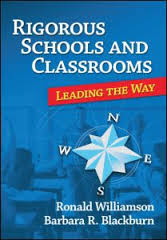Build a Rowboat Culture: 3 Tips for School Leaders


Let’s look at three tools that can help you encourage a culture of growth and success in your school, with leadership, teachers and students all rowing energetically in the same direction.
1. Share the Vision
It is important for leaders and teachers to have a personal vision that they can build collaboratively into a shared vision. The beginning of the school year is a great time to think about vision, but it can take place at any time. A Vision Letter is an engaging and motivating way for teachers to share the visions of their classrooms.
Ask teachers to imagine it is the last day of school. This year turned out to be their best year ever, one that far exceeded their expectations. Now, ask them to write a letter or e-mail to another teacher describing the past year—all that their students accomplished, the rigor of their classroom, the challenges their students met, the ways they supported student learning.
Next, ask the teachers to share their letters with some trusted colleagues. Use this as a starting point to begin discussions about common values as you work toward a shared vision of the school.

You can then use the letter as a part of a conversation with each teacher about his or her vision of a more rigorous classroom and how it relates to your vision of a more rigorous school. It also provides an opportunity for you to understand how you can help each teacher accomplish his or her goals.
2. Celebrate Positive Aspects of Your Culture
One way to celebrate a culture is to use “Name It, Claim It, and Explain It.” As you see an example of exemplary instruction in a classroom, take a digital picture or video of what occurs. Then, begin each of your faculty meetings by projecting the picture or video.
For example, if you are trying to increase rigor in your school, explain to your faculty, “I saw something great related to rigor this week. It’s up here on the screen. If it belongs to you, stand up and name what you did, claim it as yours, and explain what you were doing.”
With this tool, you celebrate something positive and reinforce your focus consistently in your meetings.
3. Recognize Your Heroes and Heroines
Every school has heroes and heroines among its students and staff. They are people who are admired by others in the school for how they go about their work and live their lives.
But there are both positive and negative examples. There are people who are admired for their commitment to the school’s values and beliefs or to a vision of a more rigorous school. Then there are those who are admired because they are cynical or pessimistic.
As a leader, you want to reinforce the people who reflect your school’s commitment to positive change in the classroom. You can do that by recognizing people who reflect the vision and have experienced success.
A principal in Tacoma, WA took photos of classroom and student activities throughout the year. The photos captured students and teachers doing things that supported the school’s vision. The photos were hung in the hallway and other public places and served as a visual recognition of the school’s heroes and heroines.
When Mill Creek Middle School was under construction, an old rowboat and an oar were found on the site. The principal hung the boat in the main office atrium and used the oar to recognize teachers for their exceptional commitment to the success of students.
Every month, the oar was awarded to one teacher who went “over and above” to support students. Dressed as an old boatman, the principal entered the teacher’s class and recognized his or her accomplishments. The oar remained in the class for that month as a visual reminder of the teacher’s commitment to her or his students.
Culture can be reshaped
Shifting the culture of your school can be a challenge. Cynicism and resistance may need to be overcome. However, there are concrete ways to help leaders effect change and support teachers and staff as they create a new paradigm.
Used consistently, these techniques and other culture-builders will help you reshape the attitudes in your school and promote increased growth in student learning.

Ron Williamson is a professor of leadership and counseling at Eastern Michigan University. Previously, he taught at the University of North Carolina at Greensboro and was a teacher, principal, and executive director of instruction in the Ann Arbor, Michigan, Public Schools. He also served as executive director of the National Middle School Association and as president of the National Forum to Accelerate Middle Grades Reform.
Barbara Blackburn is a best-selling author of 14 books, including Rigor is NOT a Four-Letter Word. A nationally recognized expert in the areas of rigor and motivation, she collaborates with schools and districts for professional development. Barbara can be reached through her website or her blog. She’s on Twitter @BarbBlackburn. See her other MiddleWeb posts here. Her latest book, Rigor in Your Classroom: A Toolkit for Teachers, was published in May 2014.































